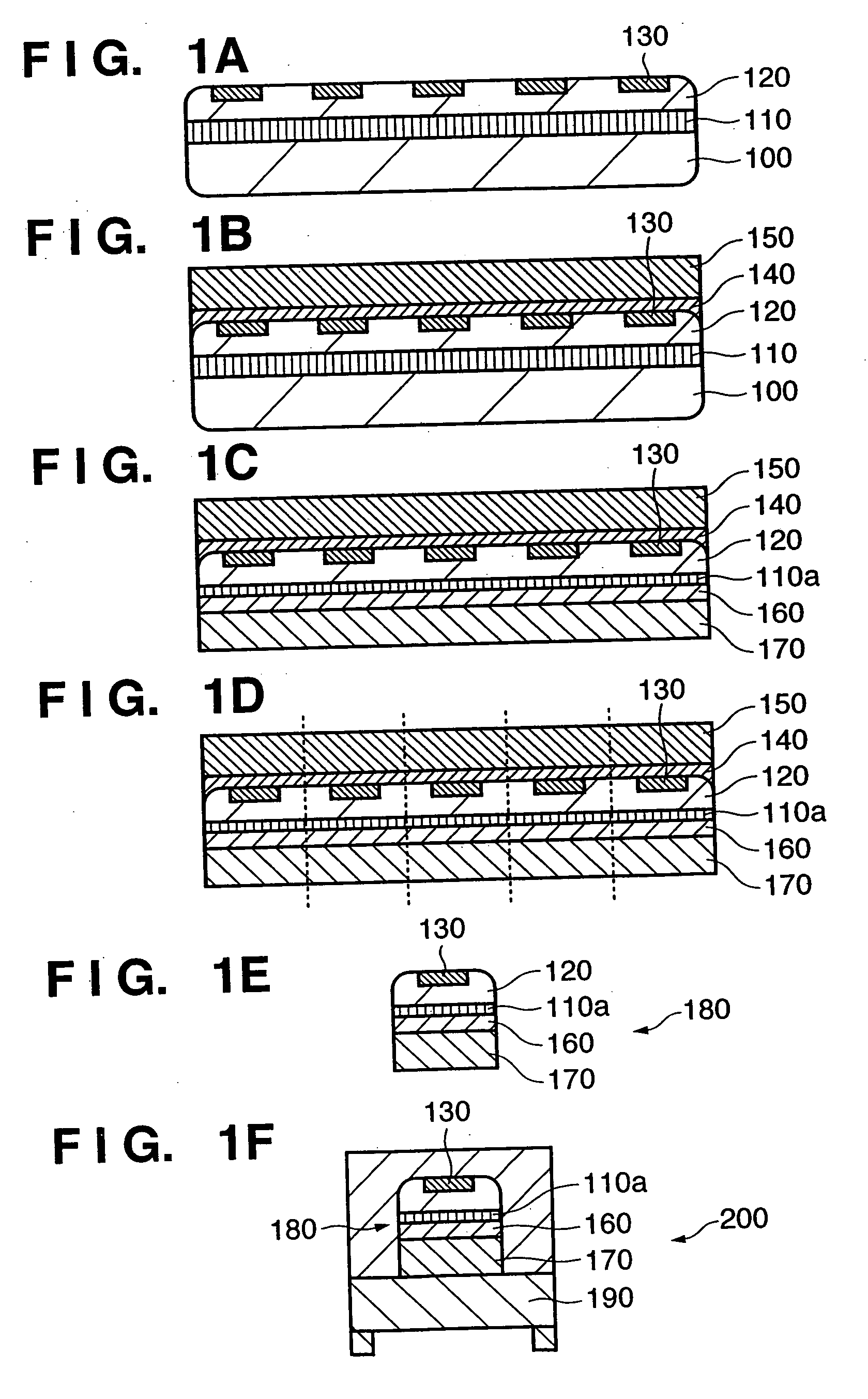Integrated circuit chip manufacturing method and semiconductor device
a manufacturing method and integrated circuit technology, applied in semiconductor devices, semiconductor device details, electrical apparatus, etc., can solve the problems of difficult to hold a chip during die bonding, patent reference 2 does not disclose the formation of chips from the semiconductor device placed on the diamond substrate, etc., to facilitate dicing and die bonding, the effect of facilitating the formation of chips
- Summary
- Abstract
- Description
- Claims
- Application Information
AI Technical Summary
Benefits of technology
Problems solved by technology
Method used
Image
Examples
first embodiment
[First Embodiment]
[0036] The first embodiment of the present invention will be described with reference to FIGS. 1A to 1F.
[0037] First, in the step shown in FIG. 1A, a separation layer 110 and semiconductor layer (semiconductor region) 120 are formed on a semiconductor substrate 100 serving as a seed substrate. Then, integrated circuits 130 including semiconductor devices are formed in the semiconductor layer 120.
[0038] More specifically, a porous layer 110 including two layers having different porosities is formed as a separation layer on the silicon substrate (semiconductor substrate) 100 serving as the seed substrate by an anodizing process. The porous layer 110 including the two layers having the different porosities can be formed by changing conditions (e.g., current conditions) for the anodizing process. When the porous layer 110 including the two layers having the different porosities is formed, the interface between the two layers can be used as a separation interface in a...
second embodiment
[Second Embodiment]
[0075] According to the second embodiment, the method of forming the separation layer of the first embodiment is changed.
[0076] First, in the step shown in FIG. 2A, an insulating layer (e.g., a SiO2 layer) serving as a protection film 210 is formed on a silicon substrate (semiconductor substrate) 100 serving as a seed substrate. In the step shown in FIG. 2B, ions such as hydrogen ions are implanted in the silicon substrate 100 to form an ion-implanted layer serving as a separation layer (ion-implanted layer) 110b in a region at a predetermined depth from the surface of the silicon substrate 100. For example, the implantation amount of the hydrogen ions can be set to the order of 1016 to 1017 (atoms / cm2).
[0077] After that, the protection film 210 is removed in the step shown in FIG. 2C. Thus, a substrate which has semiconductor layer 120a on the separation layer 110b an be formed. The substrate obtained in this manner is subjected to the steps shown in FIGS. 1B t...
third embodiment
[Third Embodiment]
[0079] This embodiment provides an optical card manufacturing method as well as a method of removing a seed substrate without using a separation layer.
[0080] First, integrated circuits including, e.g., a light-receiving element and amplification circuit, are formed on a silicon substrate serving as a seed substrate. After that, the first support member is bonded to the silicon substrate such that the integrated circuit side (first surface side) becomes inside.
[0081] Subsequently, the silicon substrate is thinned from the lower surface (second surface side) by grinding and abrasion using a grinder to leave a semiconductor layer (semiconductor region) having a predetermined thickness (e.g., 50 μm) as a region that includes integrated circuits.
[0082] Subsequently, a light-transmitting substrate (quartz substrate) serving as the second support member is bonded to the integrated circuit side (second surface side) of the obtained substrate. In this case, annealing (e....
PUM
 Login to View More
Login to View More Abstract
Description
Claims
Application Information
 Login to View More
Login to View More - R&D
- Intellectual Property
- Life Sciences
- Materials
- Tech Scout
- Unparalleled Data Quality
- Higher Quality Content
- 60% Fewer Hallucinations
Browse by: Latest US Patents, China's latest patents, Technical Efficacy Thesaurus, Application Domain, Technology Topic, Popular Technical Reports.
© 2025 PatSnap. All rights reserved.Legal|Privacy policy|Modern Slavery Act Transparency Statement|Sitemap|About US| Contact US: help@patsnap.com



